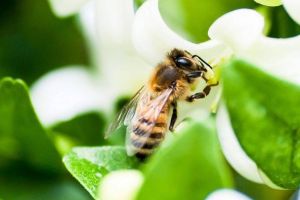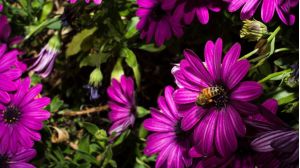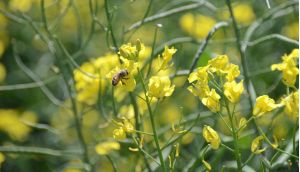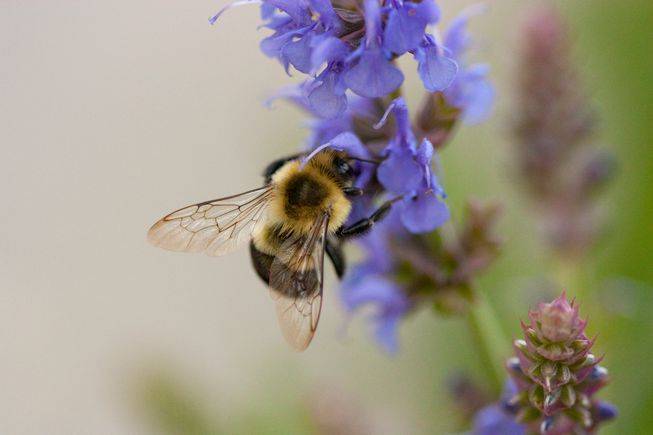As vital pollinators decline across the U.S. Midwest, one city in Iowa is launching an ambitious plan to rebuild their prairie habitat.

It's generally a bad time to be a bee in the United States. Populations of the pollinating insects have been declining for more than a decade, including managed honeybee colonies as well as various species of native wild bees.
Of course, this isn't just bad news for bees. Not only do honeybees give us honey and wax, but bees of all stripes play a pivotal role in our food supply. Bees pollinate plants that provide a quarter of the food eaten by Americans, accounting for more than $15 billion in increased crop value per year, according to the U.S. Department of Agriculture. And along with bees, many butterflies and other insects are also vital crop pollinators. As MNN's Tom Oder wrote in 2013, "one in three mouthfuls of food and drink Americans consume is the result of insect pollination."
Some big changes are needed to solve a problem this big, like curbing the use of bee-killing insecticides, studying the threat of invasive varroa mites and restoring native prairies, whose wildflowers offer key bee habitat. But as one city in Iowa plans to demonstrate, big changes like these can start with smaller, simpler actions.
On a wing and a prairie
 Native wildflowers bloom at Springbrook Prairie Nature Preserve in Illinois. (Photo: Mark Baldwin/Shutterstock)
Native wildflowers bloom at Springbrook Prairie Nature Preserve in Illinois. (Photo: Mark Baldwin/Shutterstock)
This spring, the city of Cedar Rapids will seed 188 acres with native prairie grasses and wildflowers, part of a broader plan to create a diffuse, 1,000-acre haven for bees and other pollinators. This should help local ecosystems as well as local farms, and if it works as intended, it could become a model for similar projects elsewhere.
Known as the 1,000 Acre Pollinator Initiative, the plan started with a suggestion from the Monarch Research Project (MRP), a nonprofit dedicated to reversing monarch butterfly declines. After the MRP approached the city about converting unused public land into pollinator habitat, Cedar Rapids Parks Superintendent Daniel Gibbins proposed creating 1,000 acres of prairie over five years.
"With the agricultural boom around 100 years ago, about 99.9 percent of all the native habitat of Iowa has been lost," Gibbins tells Popular Science. "When you convert it back to what was originally native Iowa, you're going to help a lot more than just native pollinators. You're helping birds, amphibians, reptiles, mammals — everything that's native here relies on native vegetation."
Bee minus

The first national study to map U.S. wild bees suggests they're dwindling in important agricultural areas. Blue indicates greater abundance of bees in the map above, while lower abundance is depicted in yellow. (Image: PNAS)
The issue of pollinator declines can seem distant or abstract, but a new study illustrates how widespread it has become. The image above is the first-ever national map of wild bee abundance, released Feb. 19 by researchers from the University of Vermont (UVM). It hints at a major problem in many of the country's most important agricultural areas, including Iowa and the surrounding U.S. Midwest.
"Most people can think of one or two types of bee, but there are 4,000 species in the U.S. alone," says Insu Koh, a UVM postdoctoral researcher who led the study. "When sufficient habitat exists, wild bees are already contributing the majority of pollination for some crops. And even around managed pollinators, wild bees complement pollination in ways that can increase crop yields."
While this map sheds light on a troubling trend, it shouldn't leave you feeling depressed, adds UVM conservation ecologist Taylor Ricketts, who directs the school's Gund Institute for Ecological Economics. "The good news about bees," Ricketts says, "is now that we know where to focus conservation efforts, paired with all we know about what bees need, habitat-wise, there is hope for preserving wild bees."

Flowers that feed monarchs often benefit other insects, too, like these bees in Wisconsin. (Photo: Richard Hurd/Flickr)
North America's pollinator declines stem from several problems, including pesticides, parasites and climate change. But one of the most pervasive issues is habitat loss, as the biodiverse meadows that once sustained bees and butterflies are replaced by human developments. Some former prairies are now roads, neighborhoods, shopping centers and parking lots, but even when they're replaced by vegetation, it tends to be monoculture crops and mowed lawns, not fields of native flowers.
To address that, Cedar Rapids has developed a special mix of native seeds, Popular Science reports, featuring 39 species of wildflowers and seven types of prairie grasses. The flowers are the obvious focal point for bees and butterflies, but the native grasses are important, too, since they'll help limit weeds and invasive species.
The prairie project is slated to unfold on a variety of unused spaces around Cedar Rapids, including parts of city parks, golf courses and the Eastern Iowa Airport, as well as less obvious habitats like roadsides, sewage ditches and water-retention basins. About 500 acres have been identified so far, and officials are working with Linn County and the nearby city of Marion to reach the 1,000-acre goal.
Some work will be required to establish and maintain the new prairie, Gibbins tells Popular Science, such as efforts to "knock back the undesirable vegetation" and spreading of native seeds in spring and fall. Still, he notes, it will require significantly less attention than a grassy lawn that must be mowed every week.
Above the lawn

Purple coneflowers, like these at a garden in Minnesota, can be a boon for native pollinators. (Photo: U.S. FWS)
This will turn Cedar Rapids into an oasis for pollinators, MRP co-founder Clark McLeod told the Cedar Rapids Gazette in 2016, but the plan isn't just to build one oasis. "We have to create a movement for this to work," he said, adding "we can be successful only if we make Cedar Rapids a model for cities all over the continent."
This kind of work isn't limited to cities or counties that can spare 1,000 acres, either. As University of Arizona pollination ecologist Stephen Buchmann tells Popular Science, the key is biodiversity that spans seasons. "When creating pollinator gardens," Buchmann says, "the most important thing is to have a big diversity of wildflowers and heirloom crops that bloom in the spring, summer and fall."
For tips on helping your local pollinators, see the related links below. But as McLeod tells local news outlet KWQC, it doesn't necessarily have to be complicated. The beauty of a flowering meadow isn't just in the flowers; it's also in learning when not to micromanage nature. "We need to get away from grooming every acre," McLeod says, "and change people's mindset as to what is beautiful."





